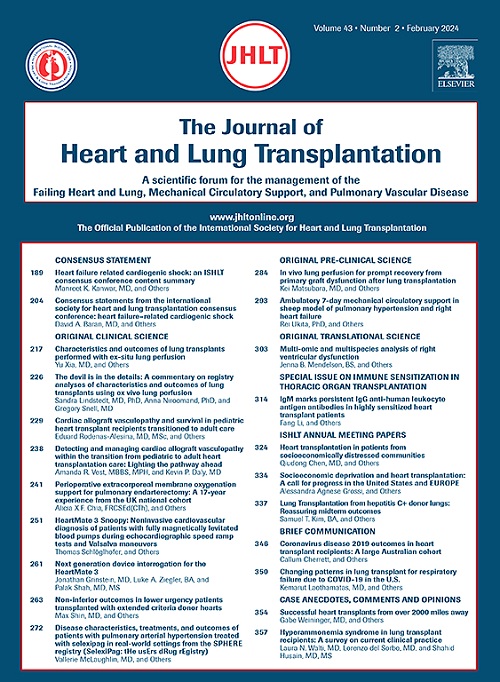Mechanical circulatory support early after pediatric heart transplantation—an analysis from the Pediatric Heart Transplant Society
IF 6.4
1区 医学
Q1 CARDIAC & CARDIOVASCULAR SYSTEMS
引用次数: 0
Abstract
Background
The use of early mechanical circulatory support (MCS) following pediatric heart transplantation is not well-published. This paper attempts to uncover the incidence, predisposing factors, and outcomes of MCS in a large, international cohort.
Methods
The Pediatric Heart Transplant Society Database (an international, prospective, event-driven database) was retrospectively analyzed for all cases of primary heart transplant over an 11-year period (2010-2020), dividing the cohort based on need for MCS within 30 days of transplantation.
Results
Of 4,321 primary transplants, 249 (5.8%) required MCS (230 ECMO (Extracoporeal Membranous Oxygenation), 19 ventricular assist device). In a Cox proportional hazard model, congenital heart disease (p = 0.0002), older donor age (p < 0.0001), and longer ischemic time (p = 0.018) were each related to an increased need for MCS; increasing recipient body surface area (p < 0.0001) and increasing donor left ventricular ejection fraction (p = 0.016) were both correlated with less MCS use. One-year survival in those requiring MCS was 54.2%, compared with 94.8% in those who did not need MCS (p < 0.0001). Later survival in patients surviving to 1 year was similar between the groups.
Conclusions
MCS is used infrequently following pediatric heart transplant and is related to donor, recipient, and transplant factors. Although mortality is high, those surviving the first year post transplant have excellent outcomes. Judicious use in those patients who would otherwise perish is therefore justified.
小儿心脏移植术后早期机械循环支持--来自小儿心脏移植协会的分析。
背景儿科心脏移植术后早期使用机械循环支持(MCS)的情况尚未得到充分报道。本文试图揭示一个大型国际队列中机械循环支持的发生率、诱发因素和结果。方法回顾性分析了儿科心脏移植协会数据库(一个国际性、前瞻性、事件驱动型数据库)11 年间(2010-2020 年)的所有初级心脏移植病例,根据移植后 30 天内是否需要 MCS 对队列进行划分。结果在 4321 例初级移植中,249 例(5.8%)需要 MCS(230 例 ECMO,19 例 VAD)。在 Cox 比例危险模型中,先天性心脏病(p = 0.0002)、供体年龄较大(p < 0.0001)和缺血时间较长(p = 0.018)均与 MCS 需求增加有关;受体体表面积增加(p < 0.0001)和供体左心室射血分数增加(p = 0.016)均与 MCS 使用较少有关。需要 MCS 的患者 1 年存活率为 54.2%,而不需要 MCS 的患者 1 年存活率为 94.8%(p < 0.0001)。结论 小儿心脏移植后很少使用MCS,这与供体、受体和移植因素有关。虽然死亡率很高,但移植后第一年存活的患者都有很好的预后。因此,有理由对那些否则会死亡的患者慎重使用。
本文章由计算机程序翻译,如有差异,请以英文原文为准。
求助全文
约1分钟内获得全文
求助全文
来源期刊
CiteScore
10.10
自引率
6.70%
发文量
1667
审稿时长
69 days
期刊介绍:
The Journal of Heart and Lung Transplantation, the official publication of the International Society for Heart and Lung Transplantation, brings readers essential scholarly and timely information in the field of cardio-pulmonary transplantation, mechanical and biological support of the failing heart, advanced lung disease (including pulmonary vascular disease) and cell replacement therapy. Importantly, the journal also serves as a medium of communication of pre-clinical sciences in all these rapidly expanding areas.

 求助内容:
求助内容: 应助结果提醒方式:
应助结果提醒方式:


